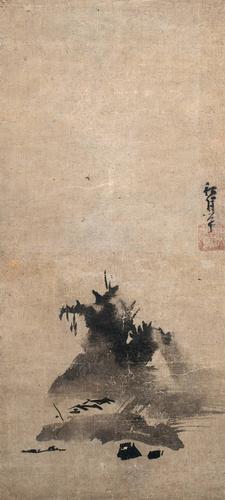|
|
|

|
a haboku landscape from around 1510, by Tokan Shugetsu
|
Haboku
Haboku means something like 'flung/broken ink'. It's not clear whether the wet
washes on haboku landscape were flung at the surface, as was apparently the case
with the Chinese forebears of this style such as Yu Chien, or brushed quickly and
more or less randomly, but the results are extraordinary whatever the case,
sometimes requiring a leap of faith from the viewer to believe in the image as
landscape, which it was always stated to be. Most often, various solid-black
additions would be made to crystallise the imagery into a landscape, and that (tree, roof, boat?)
looks to be what just about makes the example by Shugetsu (a pupil of Sesshu, and
there is another example in his section here) readable in a figurative sense; but
I am unconvinced that there was any flinging or automatic painting involved at all
here.
|
|

